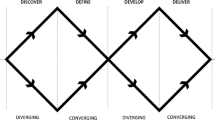Abstract
For place branding to reach long-term commitment and legitimacy a large number of stakeholders needs to be involved. This calls for innovative ways of approaching the process itself, permitting it to be participatory and changeable. In this article, the purpose is to describe, in detail, how a place branding process can take place in practice, and illustrate how an integration of design can act as a mean to reach community participation. The example is a tourism development case in Kisumu, Kenya where the authors were actively involved in destination branding. The findings show how the empathic and intuitive process of design allows each activity to lead to the other in an evolutionary way, and how visual tools can strengthen communication between participants as well as stimulate idea generation. The implication is that place branding should be viewed as consisting of several ongoing processes with multiple stakeholders. With the introduction of evolutionary and visual elements to these processes, they become more participatory, changeable and sustainable.











Similar content being viewed by others
References
Aitken, R. and Campelo, A. (2011) The four Rs of place branding. Journal of Marketing Management 28 (9–10): 913–933.
Akama, Y. (2009) Warts-and-all: The real practice of service design. In: J.V. Nisula, S. Clatworthy and S. Holmlid (eds.) Proceedings of the 1st service design and service innovation conference ServDes.2009; DeThinking Service; ReThinking Design; 24-26 November, Oslo, Norway. Linköping, Sweden: Linköping University Electronic Press, pp. 1–11.
Arnstein, S.R. (1969) A ladder of participation. Journal of American Institute of Planners 35 (4): 216–224.
Ashworth, G.J. and Kavaratzis, M. (2009) Beyond the logo: Brand management for cities. Journal of Brand Management 16 (8): 520–531.
Bailey, S. (2013) Exploring where designers and non-designers meet within the service organisation: Considering the value designers bring to the service design process. Paper presented at the 10th European Academy of Design Conference Crafting the Future; 17–19 April, Gothenburg, Sweden.
Baker, B. (ed.) (2007) Destination Branding for Small Cities: The Essentials for Successful Place Branding. Portland, OR: Creative Leap Books.
Björgvinsson, E., Ehn, P. and Hillgren, P.-A. (2010) Participatory Design and ‘Democratizing Innovation’. Proceedings of the 11th Biennial Participatory Design Conference, New York: ACM, pp. 41–50.
Braun, E., Kavaratzis, M. and Zenker, S. (2013) My city – My brand: The different roles of residents in place branding. Journal of Place Management and Development 6 (1): 18–28.
British Design Council. (2014) Introducing design methods, http://www.designcouncil.org.uk/news-opinion/introducing-design-methods, accessed 23 December 2014.
Buchenau, M. and Suri, J.F. (2000) Experience Prototyping. Proceedings of the 3rd Conference on Designing Interactive Systems: Processes, Practices, Methods, and Techniques. Association for Computing Machinery (ACM), New York, pp. 424–433.
Burns, C., Cottam, H., Vanstone, C. and Winhall, J. (2006) Transformation Design. Red Paper 02, London, British Design Council.
Cooper, R., Sabine, J. and Lockwood, T. (2009) Design thinking and design management: A research and practice perspective. Design Management Review 20 (2): 46–55.
Cross, N. (ed.) (1972) Design Participation. Proceedings of the Design Research Society’s Conference, Manchester, UK, September 1971. London: Academy editions.
Cross, N. (1981) The coming of post-industrial design. Design Studies 2 (1): 3–7.
Ehn, P. (1993) Scandinavian design: on participation and skill. In: D. Schuler and A. Namioka (eds.) Participatory Design: Principles and Practices. Hillsdale, NJ: Erlbaum Associates, pp. 41–77.
Fan, Y. (2010) Branding the nation: Towards a better understanding. Place Branding and Public Diplomacy 6 (2): 97–103.
Gedenryd, H. (1998) How designers work: Making sense of authentic cognitive activities. Dissertation, Lund University, Lund: Jabe Offset AB.
Ham, A., Butler, S. and Starnes, D. (2012) Kenya. 8th edn. Footscray, Victoria: Lonely Planet.
Hankinson, G. (2004) Relational network brands: Towards a conceptual model of place brands. Journal of Vacation Marketing 10 (2): 109–121.
Hanna, S. and Rowley, J. (2011) Towards a strategic place brand-management model. Journal of Marketing Management 27 (5/6): 458–476.
Hickey, S. and Mohan, G. (eds.) (2004) Towards participation as transformation: Critical themes and challenges. In: Participation: From Tyranny to Transformation? : Exploring New Approaches to Participation in Development. London: ZED Books, pp. 3–24.
Kalandides, A. (2011) The problem with spatial identity: Revisiting the ‘sense of place’. Journal of Place Management and Development 4 (1): 28–39.
Kapferer, J.N. (2012) The New Strategic Brand Management : Advanced Insights and Strategic Thinking. 5th edn. London: Kogan Page.
Kavaratzis, M. (2012) From ‘necessary evil’ to necessity: Stakeholders involvement in place branding. Journal of Place Management and development 5 (1): 7–19.
Kavaratzis, M. and Hatch, M.J. (2013) The dynamics of place brands: An identity-based approach to place branding theory. Marketing Theory 13 (1): 69–86.
Lawson, B. (2005) How Designers Think: The Design Process Demystified. 4th edn. Oxford: Architectural Press.
Lucarelli, A. (2012) Unraveling the complexity of ‘city brand equity’: A three-dimensional framework. Journal of Place Management and Development 5 (3): 231–252.
Massey, D. (1994) Space, Place and Gender. Oxford: Polity Press.
Moilanen, T. and Rainisto, S.K. (2009) How to Brand Nations, Cities and Destinations: A Planning Book for Place Branding. Basingstoke, UK: Palgrave Macmillan.
Pike, S. (2005) Tourism destination branding complexity. Journal of Product & Brand Management 14 (4): 258–259.
Sanders, E. B.-N. and Dandavate, U. (1999) Design for experiencing: New tools. In: C.J. Overbeeke and P. Hekkert (eds.), Proceedings of the 1st International Conference on Design and Emotion. Delft University of Technology, Delft, the Netherlands, pp. 87–92.
Sanders, E.B. and Stappers, P.J. (2008) Co-creation and the new landscapes of design. CoDesign: International Journal of CoCreation in Design and the Arts 4 (1): 5–18.
Sangiorgi, D. (2009) Building up a Framework for Service Design Research. 8th European Academy of Design Conference, The Robert Gordon University, Aberdeen, Scotland.
Schön, D. (1983) The Reflective Practitioner – How Professionals Think in Action. New York: Basic Books.
Segelström, F. (2009) Communication through visualizations: Service designers on visualizing user research. In: J.V. Nisula, S. Clatworthy and S. Holmlid (eds.) Proceedings of the 1st service design and service innovation conference ServDes.2009; DeThinking Service; ReThinking Design; 24-26 November, Oslo, Norway. Linköping, Sweden: Linköping University Electronic Press, pp. 175–185.
Segelström, F. and Blomkvist, J. (2013) External representations in service design: A distributed cognition perspective. Paper presented at the 10th European Academy of Design Conference Crafting the Future; 17–19 April, Gothenburg, Sweden.
Wall, G. and Mathieson, A. (2006) Tourism: Changes, Impacts, and Opportunities. 2nd edn. Harlow, UK: Pearson Prentice Hall.
Warnaby, G. (2009) Towards a service-dominant place marketing logic. Marketing Theory 9 (4): 403–423.
Westerlund, B. (2009) Design space exploration: Co-operative creation of proposals for desired interactions with future artefacts. Dissertation Stockholm: Kungliga Tekniska Högskolan, http://urn.kb.se/resolve?urn=urn:nbn:se:kth:diva-11210, accessed 1 September 2012.
Zenker, S. and Beckmann, S.C. (2013) My place is not your place – Different place brand knowledge by different target groups. Journal of Place Management and Development 6 (1): 6–17.
Acknowledgements
We want to give our thanks to the main funders of the project, Mistra Urban Futures, which is a centre for sustainable urban development with headquarters in Gothenburg, Sweden, and their Local Interaction Platform in Kisumu (KLIP). We would also like to thank all the people in Dunga who have participated. Thanks also to the two reviewers for their comments and suggestions on structure and contents of the article.
Author information
Authors and Affiliations
Corresponding author
Rights and permissions
About this article
Cite this article
Jernsand, E., Kraff, H. Participatory place branding through design: The case of Dunga beach in Kisumu, Kenya. Place Brand Public Dipl 11, 226–242 (2015). https://doi.org/10.1057/pb.2014.34
Received:
Revised:
Published:
Issue Date:
DOI: https://doi.org/10.1057/pb.2014.34




